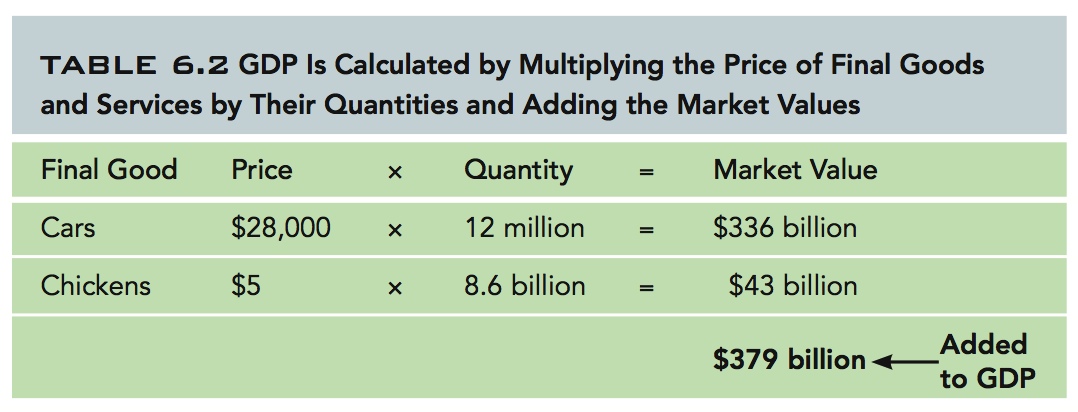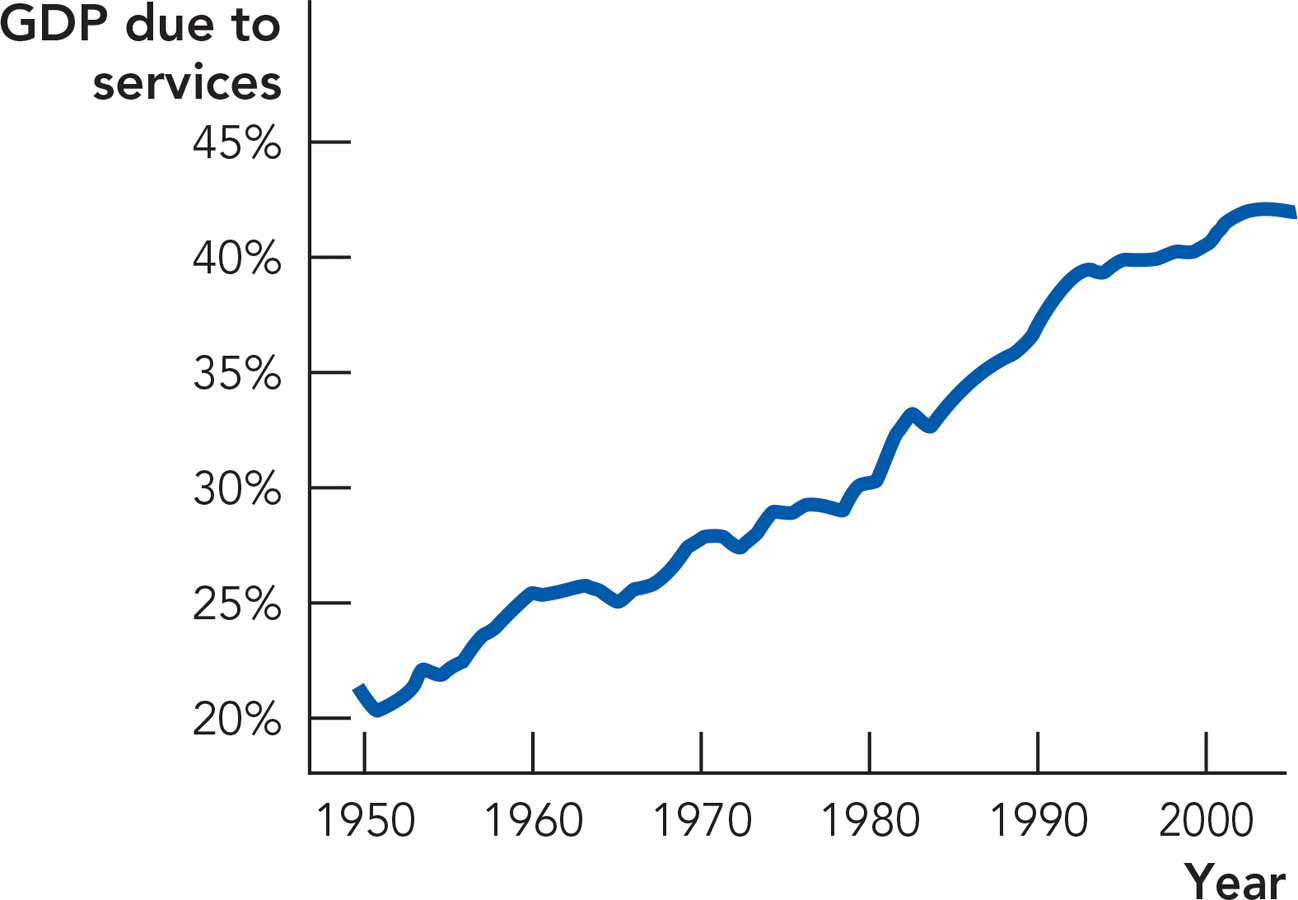What Is GDP?
Gross domestic product (GDP) is the market value of all final goods and services produced within a country in a year.
Gross domestic product (GDP) is the market value of all final goods and services produced within a country in a year. GDP per capita is GDP divided by a country’s population.
GDP per capita is GDP divided by population.
To repeat, GDP is the market value of all final goods and services produced within a country in a year. Let’s take each part of this statement in turn.
GDP Is the Market Value …
GDP measures an economy’s total output, which includes millions of different goods and services. But some goods are obviously more valuable than others: A Ford Mustang is worth more than an iPad. To measure total output, therefore, it doesn’t make sense to simply add up quantities. Instead, GDP uses market values to determine how much each good or service is worth and then sums the total.
For example, in 2005 the U.S. economy produced approximately 12 million cars and light vehicles and 8.6 billion chickens.1 If the average price of a car was $28,000 and the average price of a chicken was $5, the market value of the production of cars was $336 billion ($28,000 × 12 million) and the market value of chicken production was $43 billion ($5 × 8.6 billion). Using prices in the calculations gives greater weight to goods and services that are more highly valued in the marketplace. Applying this procedure to all final goods and services yields a figure for GDP. In Table 6.2, we show the addition to GDP created by the production of cars and chickens.

… of All Final …

What is a final good or service? Some goods and services are sold to firms and then bundled or processed with other goods or services for sale at a later stage. These are called intermediate goods and services. We distinguish these from final goods and services, which are sold to final users and then consumed or held in personal inventories.
A computer chip is one example of an intermediate good. If an Intel chip were counted in GDP when it was sold to Dell, and then counted again when a consumer buys the Dell computer, the value of the computer chip would be counted twice. To avoid double counting, only the computer—the final good—is included in the calculation of GDP.
We do, however, count the production of machinery and equipment used to produce other goods as part of GDP. A tractor, for example, may help to produce soybeans, but the tractor is not part of the final product of soybeans. Thus, both tractor production and soybean production add to GDP, even though the computer chip does not.
… Goods and Services …
The output of an economy includes both goods and services. Services provide a benefit to individuals without the production of tangible output. For example, paying a consultant to fix a software problem on a computer is a service and its market value is included in GDP. Other services include haircuts, transportation, entertainment, and spending on medical care.
Since 1950, the portion of U.S. GDP created by the production of services has doubled from 21% to 42% (see Figure 6.2). Much of this increase is attributable to spending on medical services and recreational activities, which have both increased to more than 10 times their levels in 1950.2
FIGURE 6.2

Since U.S. GDP is about $16.8 trillion (2013), we can tell from the graph that the value of final services is about $7.05 trillion (0.42 × 16.8) and the value of final goods about $9.77 trillion (0.58 × 16.8).
… Produced …
GDP is meant to measure production so sales of used goods are not included in GDP. The sale of a used car, for example, is not included in GDP.
Similarly, sales of old houses and sales of financial securities like stocks and bonds are not included in the calculation of GDP. The sale of an old house does not add to GDP because the house was not produced in the year in which it sold. Sales of newly built houses, however, are counted in GDP. Stocks and bonds are claims to financial assets—they are not themselves produced goods or services—so sales of financial assets are not counted in GDP.
Even though the sales of old houses, used goods, and financial assets do not add to GDP, the services of real estate agents, used-car salespeople, and brokers do add to GDP because the services provided by these agents are produced in the year in which they are sold.
… within a Country …
U.S. GDP is the market value of the goods and services produced by labor and capital located in the United States, regardless of the nationality of the workers or the property owners. A citizen of Mexico who works temporarily in the United States adds to U.S. GDP By the same reasoning, an American who works temporarily in Mexico contributes to Mexican GDP, not to U.S. GDP.
Gross national product (GNP) is the market value of all final goods and services produced by a country’s permanent residents, wherever located, in a year.
Gross national product (GNP) is very similar to GDP but GNP measures what is produced by the labor and property supplied by U.S. permanent residents wherever in the world that labor or capital is located, rather than what is produced within the U.S. border. For a large nation like the United States, GDP and GNP are very similar but GDP has evolved into the more commonly used concept.
… in a Year
CHECK YOURSELF
Question 6.1
 The Interstate Bakeries Corporation buys wheat flour to make into Wonder Bread. Does the purchase of wheat flour add to GDP?
The Interstate Bakeries Corporation buys wheat flour to make into Wonder Bread. Does the purchase of wheat flour add to GDP?
Question 6.2
 On eBay, you sell your collection of Pokémon cards. Does your sale add to GDP?
On eBay, you sell your collection of Pokémon cards. Does your sale add to GDP?
Question 6.3
 An immigrant from Colombia works as a cook in a New York restaurant. Is the money he earns considered part of the GDP of the United States or Colombia?
An immigrant from Colombia works as a cook in a New York restaurant. Is the money he earns considered part of the GDP of the United States or Colombia?
GDP tells us how much the nation produced in a year, not how much the nation has accumulated in its entire history. You can think of GDP as being analogous to annual wages. Wages are not the same thing as wealth. Some retired people are wealthy even though their wages are low and some people with high wages have very little wealth (perhaps because they are at the beginning of their career or perhaps because they spend everything they earn and never save).
National wealth refers to the value of a nation’s entire stock of assets. A tractor built in 2005 and still operating today is part of U.S. wealth but not part of today’s GDP. One very crude estimate places U.S. national wealth at $57.4 trillion,3 which is several times larger than its GDP of about $13 trillion.
Although we typically think of GDP on a yearly basis, it is also calculated every quarter of the year. The calculations are done by the Bureau of Economic Analysis (BEA), which is part of the Department of Commerce and based in Washington, D.C. If you want to see whether you understand what the bureau is up to, try testing yourself with the questions at right.